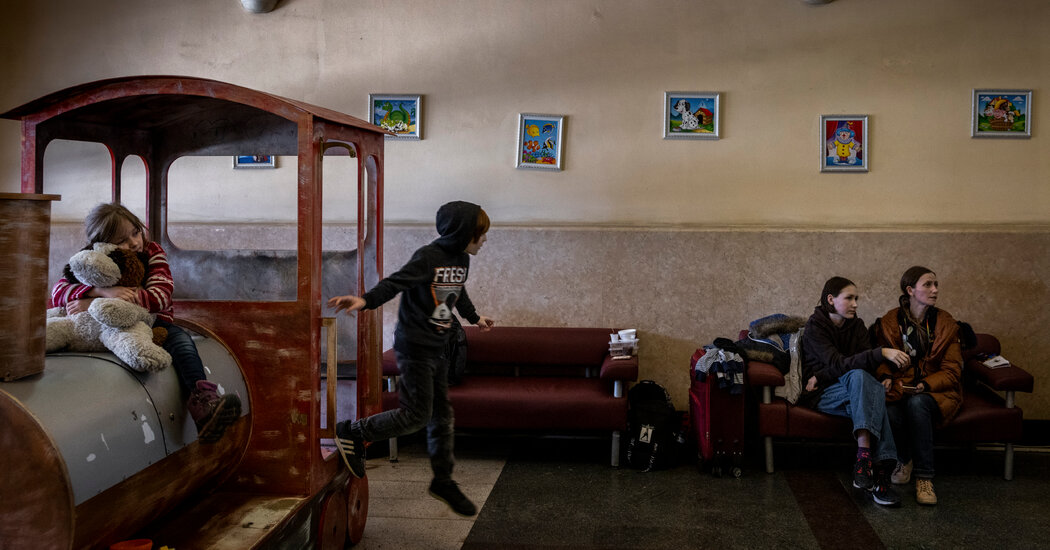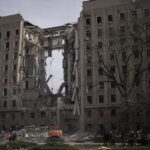
KYIV, Ukraine — Thousands of people have been fleeing the northern outskirts of the Ukrainian capital, Kyiv, escaping towns and villages under attack by Russian troops across the region. Many of them are from the city of Chernihiv, with bleak faces and crushing stories.
They have been arriving in steady droves in recent days at Kyiv’s central station, clutching bags and children, their eyes hollow and full of strain.
“The city is under fire all the time,” said Iryna Shepetova, 35, hugging one of her children after sleeping the night on a bench in the station. “The mayor told us you are responsible for your own lives.”
She escaped with her three children and her mother on one of the last minibuses out of the city last week, as Russian forces closed in.
Chernihiv guards the left bank of the Dnieper River and has been a target for Russian forces advancing on Kyiv since the start of the war five weeks ago. Thwarted from seizing control of Chernihiv, Russian units surrounded it and pounded it with airstrikes and artillery fire, as a second battalion group moved in to encircle it from the south.
On Tuesday, in negotiations in Istanbul aimed at ending the war, the Russians said they would ease their bombardment of Chernihiv, but their positions around it are already so fortified, and the city itself so battered, that the offer hardly amounted to a concession at all.
“They were purposely bombing schools,” said Vera Kaydash, 67, a retired physician. “There were lines for bread and water and they fired on the people waiting.” She said she knew two people who were among those killed in an attack on a line outside a grocery store.
Water and electricity were out, only gas was working on one side of town, and telephone and internet services were down, she said. In her former hospital, the damage had made the X-ray and dialysis departments unusable, she said. “They destroyed them in such a way that only after the war would we be able to replace them.”
“I have not seen such cynical behavior in my life,” she said.
So when the city’s mayor, Vladyslav Atroshenko, urged those who could to get out and volunteers from a private bus company organized minibuses, dozens of people decided to risk it. Cars trying to escape had come under repeated fire and there was no guarantee of safe passage for civilians, but the situation inside the city was becoming increasingly precarious.
“A great number of cars came under fire and many people died,” said Dr. Kaydash’s husband, Mikhail, 68, who accompanied his wife and sister. He said he was surprised that they got through. “We were lucky, it was quiet.”
They made a tortuous six-hour journey along back roads through woods and fields to avoid Russian positions, listening to the pounding of tank and mortar fire not far away.
Ms. Shepetova left behind her husband since, she said, men between the ages of 18 and 60 were not allowed to board the buses. Dr. Kaydash left behind her daughter and family.
Then three days after their escape, Russian planes bombed the only bridge leading out of Chernihiv, cutting the exit route for tens of thousands of Ukrainian civilians and soldiers still inside. There remains a pedestrian bridge across the river but it is damaged and exposed to Russian shelling and gunfire, the mayor said.
He asked for help for his besieged city last weekend in a video call with journalists. “We are looking for way to bring 44 seriously wounded people out,” he said. “They need urgent evacuation.” The wounded were mostly military, he said, but included civilians and three children.
More than 200 people had been killed in attacks on Chernihiv, he said, adding that destruction was so extensive, “it is now easier to count those buildings that have not been damaged.”
Since then, families have still been trickling out on increasingly dangerous journeys, making their way from the city on foot and ferried across the river by volunteers in small boats. Many are so terrified of the prospect of a Russian takeover that they did not want their full names published, but recounted their experiences.
One family said they walked and drove for three days through villages before finding a way across the river. “We were a group of seven with one child and a grandmother who is disabled,” said Svetlana, 40. “We had to make a huge hook around, for 50 kilometers, with him,” she said pointing to her five-year-old son, Dyma. They loaded their bags onto two bicycles and pushed them along, she said.
People described a chaotic and dangerous situation with front lines shifting as Russian forces sought to encircle the city and Ukrainian forces mounted a counterattack.
“All the ways out of Chernihiv are being shot at by the Russians,” said Alyona Sukhova, who drove out with her husband and 14-year-old daughter, Olha, from a rural area south of the river on Monday. “It was risky,” said her husband, Pavlo Sukhov, who did the driving. “The Russians had been pushed back a bit so there was a small window to get out.”
As fighting swirled around the city, ordinary civilians going about their work were caught up in incomprehensible shootings.
Two women from Chernihiv were working as cooks in a factory in the nearby town of Sevchenkove when it was stormed by Russian troops. “The first day a woman and a man were shot in their car,” said one of the women, Alla, 44. “It was scary to go out at all.” They sheltered in the basement of their hostel and then a Russian tank fired point blank at the building.
“They shot with tanks on our building,” said the other, Yulia, 55. “Thank God nothing fell on us.” The two women caught a ride in someone’s car and fled, but they were now homeless since they could not return to Chernihiv. Alla said her 17-year-old son was stuck there.
Russia-Ukraine War: Key Developments
Ongoing peace talks. During peace talks between Russia and Ukraine in Istanbul, Russia promised it would “reduce military activity” near Kyiv, and Ukraine said it was ready to declare itself permanently neutral. Even so, weeks of further negotiation may be needed to reach an agreement, and Russia appears determined to capture more territory in eastern Ukraine.
On a road south of Chernihiv a mechanic, Vitaliy, 42, was fetching supplies of flour from a farm several weeks ago when he ran into a column of Russian tanks and armored personnel carriers advancing from the opposite direction.
“It’s one in a million that I am alive,” he said, nursing a shattered arm and bandaged eye at a hospital on Kyiv’s left bank. “I got two bullets in my head,” he added, pulling up the hospital X-rays on his phone.
When he saw the column he stopped his car, Vitaly said, and pulled off the road, but the Russian troops opened fire on his car so he ran into the field and lay down.
“There was no cover and then they started shooting at me,” he said. Bullets were flying around him and until one shattered his arm and another pierced his eye, lodging in his brain. He remained conscious as the convoy passed and Ukrainian members of the territorial defense rescued him. “I thought the column would just go by,” he said simply.
Dropped off at the central train station in Kyiv, the evacuees from Chernihiv sat exhausted on benches in the vaulted passenger halls, waiting for trains to safer destinations in central or western Ukraine. They expressed relief but also some resentment at those ignorant of the scale of the war in their city.
“Kyiv is relatively safe,” Ms. Shepetova said, looking around. “But there are a lot of military forces and I would like to see them where they are needed.”
Mr. Kaydash called for more international help, especially in stopping the Russian air attacks.
“If Chernihiv falls, the Russians will come to Kyiv,” he said. “The Ukrainians are fighting furiously. It would be nice to have some support.”
Mr. Kaydash listed the countries where Russia has seized territory over the last 30 years. “It began from Moldova and Georgia and continued in Ukraine,” he said. “And there is Poland next door. Ukraine might be not the end. It might continue.”




